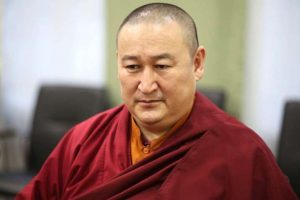
Kyabgön Phakchok Rinpoche is a well-known Nyingma teacher and chief lineage holder of the Taklung Kagyu school. He has published and taught widely internationally, with his most recent book published by Shambhala Publications: In the Footsteps of Bodhisattvas: Buddhist Teachings on the Essence of Meditation (2020). The book’s editor, Jack deTar, notes that this is a collection of Phakchok Rinpoche’s favorite quotes from the King of Meditation Sutra, which are presented anew for the reader to enjoy and take inspiration from:
Rinpoche sifted through his personal copy of the sutra and selected lines from the Tibetan that he felt were most potent for his own training. He then asked Oriane Lavole of Lhasey Lotsawa Translations and Publications to render these lines in English. (xiii)
It could perhaps also be understood as Phakchok Rinpoche’s tribute to the sutra. Right from the outset, he states:
The sutra teaches us to be naturally virtuous, gentle, and loving. It teaches us how to see clearly, to speak clearly, how to consider the Buddha’s teachings, and how to sustain the power of mindfulness. It leads to the exhaustion of habits and shows us how to go beyond the pain of samsara, the endless cycle of suffering. (10)
There is no doubt that this sutra holds a beloved place in Phakchok Rinpoche’s heart.
The King of Meditation Sutra, otherwise known as the Samadhiraja Sutra in Sanskrit, is an early Mahayana scripture that has affinities with the Prajnaparamita collection of scriptures. Despite being popularly associated with the Madhyamaka school, it is very hard to assign it any sectarian identity and it seems more representative of presenting a “general doctrine” for practitioners in its day. As it seems unlikely to have been a sectarian work, the universality and doctrinaire-free character of this sutra mean that anyone can find something of inspiration and spiritual motivation within.
The compilation of the sutra’s verses in this particular book is neither systematic nor formal. Rather, it is a personal distillation of Phakchok Rinpoche’s favorite quotes. This book is therefore best approached as a series of selected meditations, with additional exercises that will sharpen our understanding of said meditations. It is a training manual suitable for practitioners across the spectrum of experience and knowledge. As Rinpoche writes:
If we spend time reflecting on these passages and we apply the instruction and methods offered in each chapter, we will undoubtedly experience positive results. After all, we are studying and practicing the words of the Buddha. (2)
The book’s main body is split into 13 chapters. In each, Rinpoche highlights a passage from the King of Meditation Sutra, before explaining the passage through his own commentary. Each chapter ends with a simple exercise which the reader can practice in their own time to nurture what they have learned. Some themes require more explanation than others. For example, the chapter on “Renouncing Suffering” is accompanied by a lengthier-than-usual exercise called Cultivating Renunciation, which concludes with a thoughtful reminder:
Remember that the Buddha’s teaching on renunciation is a form of self-compassion. Renunciation is how we become free. (41)
This chapter also happens to include one of my favorite segments: Phakchok Rinpoche stands firm against relativism and bad-faith recasting of the Buddha’s teachings:
When you try to change too much of the Buddha’s teaching to fit your current worldview, then your habits don’t change. Sometimes the Buddha’s teachings are not so nice to hear, but that is the point! The Buddha’s teachings may be displeasing if your current way of living and set of values reflect a mistaken understanding of what brings happiness. When I go to the doctor and he tells me I need to eat healthier food, I don’t like it! I try to reinterpret what he says. My reinterpretation doesn’t hurt the doctor; it hurts me. For the same reason, we must not reinterpret Dharma teachings too liberally. The purpose of practice is not only to achieve happiness in this lifetime but also to gain fearlessness in the face of death. (38–40)
Another example of the book’s three-step inspirational “spiritual meditation” structure can be found in chapter nine, on “Joyful Patience”:
If, without laziness but with joyful effort, you truly work toward supreme awakening, your quest for samadhi is pure. Therefore, Youth, a bodhisattva who wishes to cultivate this samadhi with joyful effort and no regard for his own life is always following my example. (Chapter 17 of the King of Meditation Sutra) (113)
Phakchok Rinpoche then expounds on the virtues and practices of patience:
When you see diligence in yourself, rejoice. For some time, the path will oscillate between strenuousness and joyful momentum. For example, when writing this book, I went through the King of Meditation root text and selected quotes that would be useful to explain, that would help you. This took a lot of exertion, yet there was virtue in it. In the evening, I would close the sutra and lie down, knowing I had engaged in positive activity. I would supplicate the gurus and buddhas and then go to sleep. When I woke up in the morning, I would do some practice, look at the sutra again, mark more quotations, and at night I would sleep again, knowing I had been active for others’ sake. With this effort came joy. (122)
Finally, Rinpoche proposes an exercise to reinforce his teaching in the reader-student’s mind:
See your own afflictions without becoming obsessed with eradicating them. Calmly and continuously practice in order to reduce the power of these afflictions. (123)
In this sense, each chapter functions almost like a short class in which Rinpoche gives his students a reading to practice and reflect on for the day. The assurance that these passages were specially selected by Rinpoche renders the suggested exercises all the more beneficial.
This is a digestible and enriching collection of maxims and exhortations that are at once sober and comforting. It challenges and motivates us, at the same time urging us to go beyond our comfort zone in our practice while always pulling us back to the grounded experience and memories of Rinpoche’s stories and reflections. The book helps us to absorb, intimately, the same wisdom that Phakchok Rinpoche gathered from the King of Meditation Sutra.
The strength of books like these is primarily their accessibility and heuristic power. Despite the physical accessibility of English-language Buddhist scriptures (in fact, most of them can be conveniently ordered online these days), we still often wish to learn what contemporary masters have to say about them, or applied wisdom from their own reading of the texts. To have Phakchok Rinpoche provide his own thoughts and reflections on the King of Meditation Sutra’s passages, and for him to offer tailored exercises for each theme, truly brings to mind the idea of a “class” within the pages of this book, as if Rinpoche is teaching us in person from afar.
References
Phakchok Rinpoche. 2020. In the Footsteps of Bodhisattvas: Buddhist Teachings on the Essence of Meditation. Boulder: Shambhala Publications.
See more












